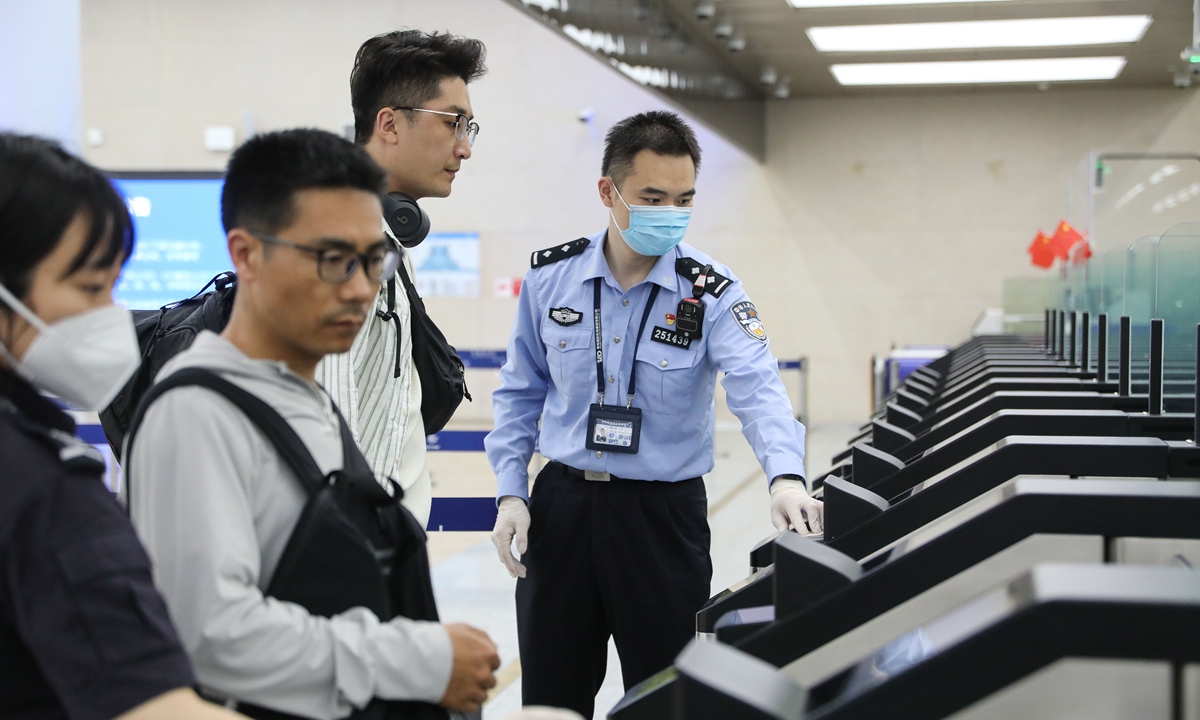
Passengers pass the fast-lane quaratine channel on May 15, 2023 at the Qingdao airport in East China's Shandong Province. Photo:VCG
Chinese exit-and-entry ports in major cities including Beijing, Shanghai and Guangzhou on Monday fully resumed fast-lane services, as one of the country's efforts to facilitate cross-border travel, a move that was welcomed by travelers for improved convenience.
In Beijing alone, all 113 fast lanes at its two international airports were put into operation. In these lanes, passengers can use their identity cards at the first gate, and then pass through the second gate to finish the customs clearance procedure after relevant information is checked such as face and fingerprint identification, according to the Beijing immigration inspection authorities.
On Monday morning, many passengers came to the border inspection hall of Shanghai Pudong International Airport to deal with the border exit procedures. The border inspection authorities posted guidance and tips on the site, and added more police officers to guide travelers in an orderly manner, according to local authorities.
As of 10 am on Monday, nearly 5,000 passengers had used fast-lane services for exit-entry procedures, accounting for more than 50 percent of the total inbound and outbound passengers, said Hu Shiyun, an official at the Shanghai airport immigration inspection station.
There were nearly 400 passengers who used the fast-lane services in the first hour after the Guangzhou Baiyun International Airport in Guangzhou, South China's Guangdong Province, resumed the services on Monday.
Ports in other cities including Shenzhen of Guangdong Province, Nanjing in East China's Jiangsu Province, Qingdao in East China's Shandong Province, and Xiamen in East China's Fujian Province all fully resumed the fast-lane services.
Several ports have seen a steadily rising number of arrivals and departures thanks to optimized travel policies. In Beijing alone, the average daily number of inbound and outbound passengers in May was nearly six times that of January, said the Beijing immigration inspection authorities.
Shanghai Pudong airport handled 540,000 entry and exit trips in the most recent two weeks, a daily average of 38,000 arrivals and departures.
Hong Yong, an expert from the think tank "digital real economies integration Forum 50," said that the optimized measures will facilitate ties and cooperation between China and other countries, which will support China's economic recovery.
The more convenient customs clearance can promote cross-border trade and boost tourism, injecting vitality into tourism-related industries, Hong said.
The travel policy optimization is more of "a favorable supporting policy" to back the Hong Kong and Macao special administrative regions, which are ready to win back travelers, investors and businesspeople as they step out of COVID-19 in 2023, Liang Haiming, dean of the Hainan University Belt and Road Research Institute, told the Global Times on Monday.
The
National Immigration Administration (NIA) announced four optimization measures on May 11, which took effect on Monday. A wide range of residents can use fast lanes for expedited border inspection including residents with Chinese passports, exit-entry permits for traveling to and from the Hong Kong and Macao special administrative regions, or permits to and from the Taiwan island, according to the NIA.




